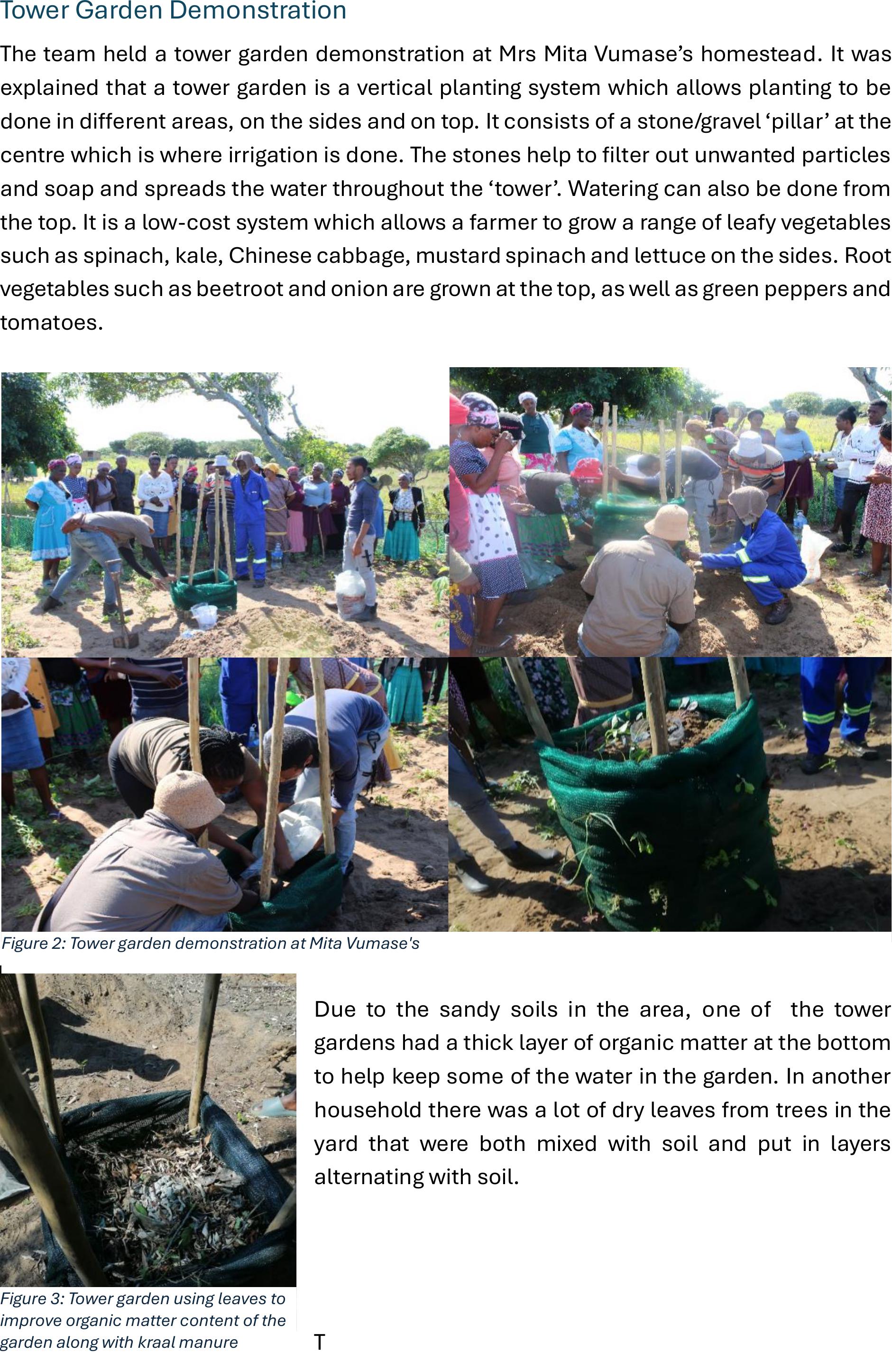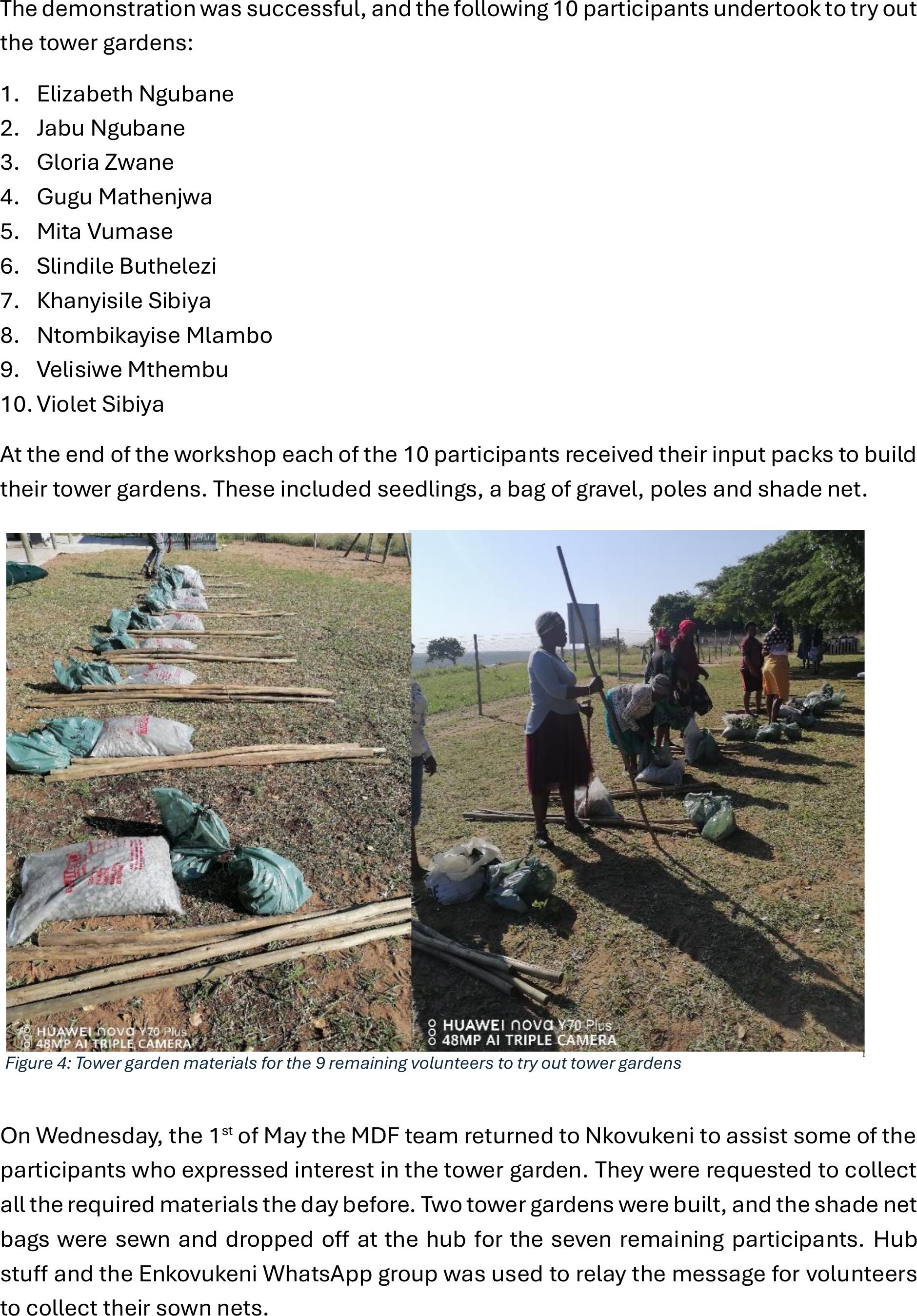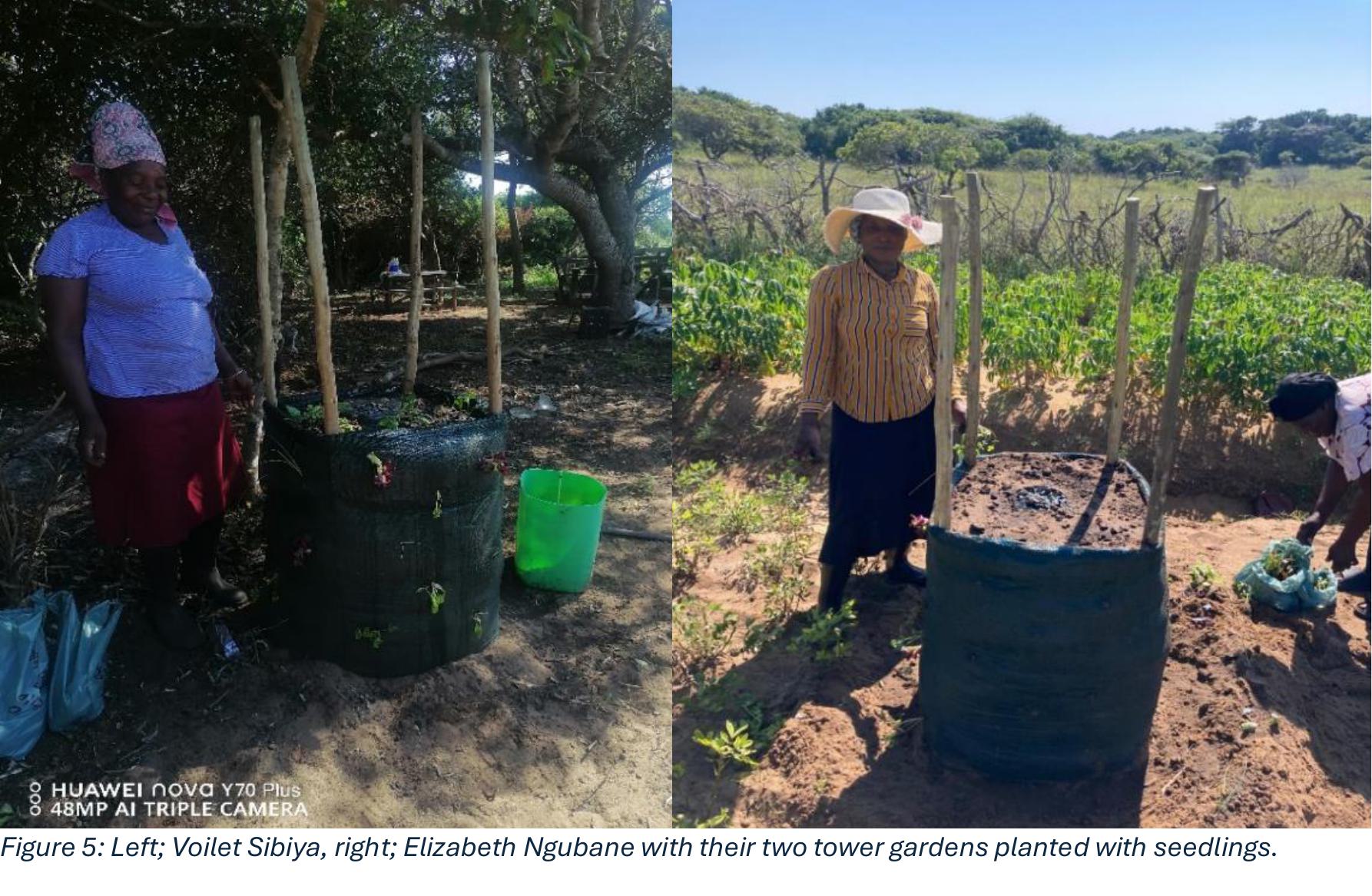
ENKOVUKENICLIMATECHANGE ADAPTATION WORKSHOPANDDEMONSTRATION
Date: 30 April 2024
Time: 09h00
Venue:Enkovukenicommunity resource hub
Participants in Nkovukeni were eager to get into action and start with practices in efforts
to improve and adapt their production activities to the changing climatic conditions. This
day was a combination ofa presentation ofclimate change adaptation proposed
activities across themes ofsoil, water, and crop managementalong withsoil fertility,
taking care ofindigenous environment aswellas a demonstration on one of the
practices. This document isa breakdown of the day’s discussion with participants on
different potential activities as well as the demonstration.
Field and hub staff collectively ferried inputs across the lake in the community boat and
up the steep slope all the way to the hub; this included gravel stone, droppers, shade
netting, seedlings, and refreshments. Unfortunately gravel stone was too heavy for the
ladies to carry and this meant guys had to do repeatedtrips to carry the ten bags of gravel
to the hub.

Workshop 2: CCA Practices
MahlathiniDevelopment Foundationhas begun a series of climate change adaptation
workshops inEnkovukeni, Zululand. One ofthe key objectives of the workshops is to build
capacity amongindividuals and the community of Enkovukeni to eectively respond to
climate change challenges. Through the interactive sessions from these workshops,
participants gain insights into variousadaptation strategies such as ecosystem-based
approaches, technological innovations, and community engagement initiatives.
The rst workshop was completed in the rst week of April. On the 30th of April, the team
completed day two of the workshop which was mainly apresentation of climate change
adaptation (CCA) practices and a practical demonstration of a tower garden, which is the
rst intervention implemented by the organisationin the area. This workshop and
demonstrationserved as part of a collective responseto Climate Change and emerges
as a valuable platform for knowledge sharing and collaboration. The workshop was
attended by 23 farmers of which majority were female.
Discussions
The workshop opened with a short recap of workshop 1,which was an introduction to
climatechange and its impacts on nature, human life, and rural livelihoods. In the rst
workshop it was highlighted that the reality of climatechange necessitates ashiftinthe
way people interact with their environment and has increased the urgency to formulate
solutions which will ensure long term sustainability and resilience. As the purpose of this
Figure 1: Field and hub sta ferrying inputs across the lake

workshop was to present possible CCA practices, the group was asked to share the main
factors they consider when preparing for their farming activities. This exercise was aimed
at understandingtheir thoughtprocessesand ideologies that inform their farming
practices. The responses focused primarily on procurement of inputs, water access and
land preparation. When probed on the practices they use when farming, thegroup shared
that planting is done mainly by hand and they use manure toboost fertility. In terms of
water access,the group shared that this is amajor challenge which is why they prefer
planting closer tothe lakes and wetlands.
Following the abovediscussionwas the presentationof CCA practices wherethe core
principles of sustainable farming were outlined which included: low use of external
inputs, maximising diversity, improvement soil health and fertility, water conservation as
well as collaboration. It was explained to thegroup that farming goes beyondjust
obtaining food and raw materials from the soil, but humans also have a responsibility to
replenish the soiland water resources if farming activities are to be sustained over time.
The team discussed that climate change eects cannot be mitigated using aone-
dimensional approach but require aholistic approachtostrengthen farmingresilience.
The ve-nger model of soil and water conservation was introduced which includes:
•Water management
•Limiting soil movement
•Crop management
•Soil health and fertility
•Taking care of indigenous plants
The discussion around the ve-nger model was followed by a detailed presentation of
the CCA practices which were grouped within the ve categories. Under water
management, practices included the building of tower gardens, check dams, under
ground storage tanks, diversion ditches and grey water use amongstothers. In terms of
limiting soil movement, practices such as conservationagriculture,diversion ditches,
stone lines, contours and terraces were discussed. Practices under soil fertility included
use ofmanure, liquid manure, eco circles, trench beds and intercropping with
leguminous crops amongst others. Following the plenary session was the demonstration
of the tower garden which was facilitated by Mazwi.

Tower Garden Demonstration
The team held a tower garden demonstration at Mrs Mita Vumase’s homestead. It was
explained thata tower garden is a vertical planting system which allows planting to be
done in dierent areas, on the sides and on top. It consists of a stone/gravel ‘pillar’ at the
centre whichiswhere irrigation is done. The stones help tolter out unwanted particles
and soap and spreads the water throughout the ‘tower’. Watering can also be donefrom
the top. It is a low-cost system which allows a farmer to grow a range of leafy vegetables
such as spinach, kale, Chinese cabbage, mustard spinach and lettuce on the sides. Root
vegetables such as beetroot and onion are grown at the top, as well as green peppers and
tomatoes.
Due to the sandy soils in the area, one of the tower
gardens had a thick layer of organic matter at the bottom
tohelp keep some ofthe water in the garden. In another
household there was a lot ofdry leavesfrom trees inthe
yard that were both mixed with soil and put in layers
alternating with soil.
T
Figure 2: Tower garden demonstration at Mita Vumase's
Figure 3: Tower garden using leaves to
improve organic matter content of the
garden along with kraal manure

The demonstration was successful, and the following 10 participants undertook to try out
the tower gardens:
1.Elizabeth Ngubane
2.Jabu Ngubane
3.Gloria Zwane
4.Gugu Mathenjwa
5.Mita Vumase
6.Slindile Buthelezi
7.Khanyisile Sibiya
8.Ntombikayise Mlambo
9.Velisiwe Mthembu
10.Violet Sibiya
At the end of the workshop each of the 10 participants received their input packs to build
their tower gardens. These included seedlings, a bag of gravel, poles and shade net.
On Wednesday, the 1st of May the MDF team returned to Nkovukeni to assist some of the
participants who expressed interest in the tower garden. They were requested tocollect
all the required materials the day before. Two tower gardens were built, and the shade net
bagswere sewn and dropped o at the hub for the sevenremaining participants. Hub
stu and the Enkovukeni WhatsApp group was used to relay the message for volunteers
to collect their sown nets.
Figure 4: Tower garden materials for the 9 remaining volunteers to try out tower gardens

Figure 5: Left; Voilet Sibiya, right; Elizabeth Ngubane with their two tower gardens planted with seedlings.